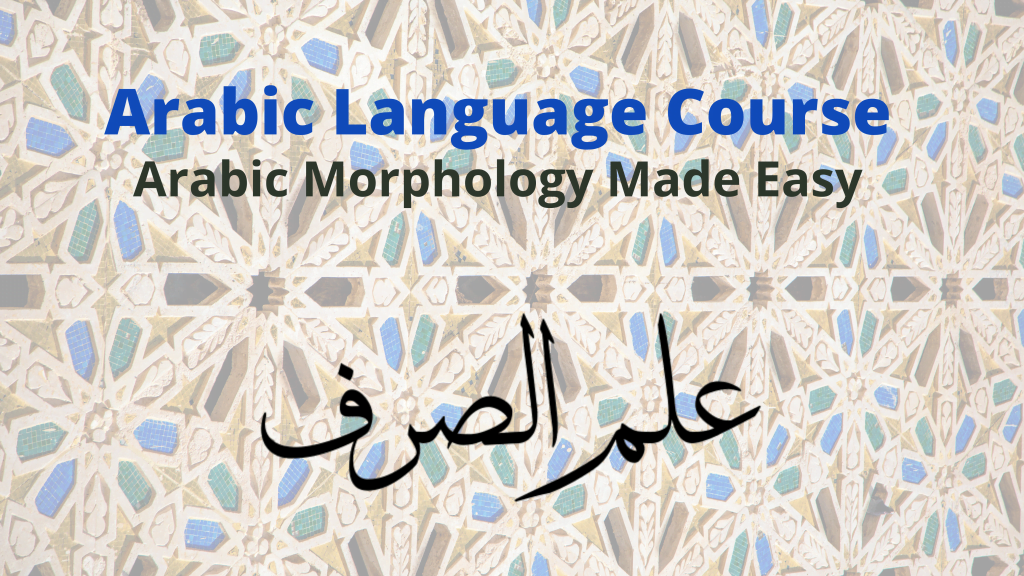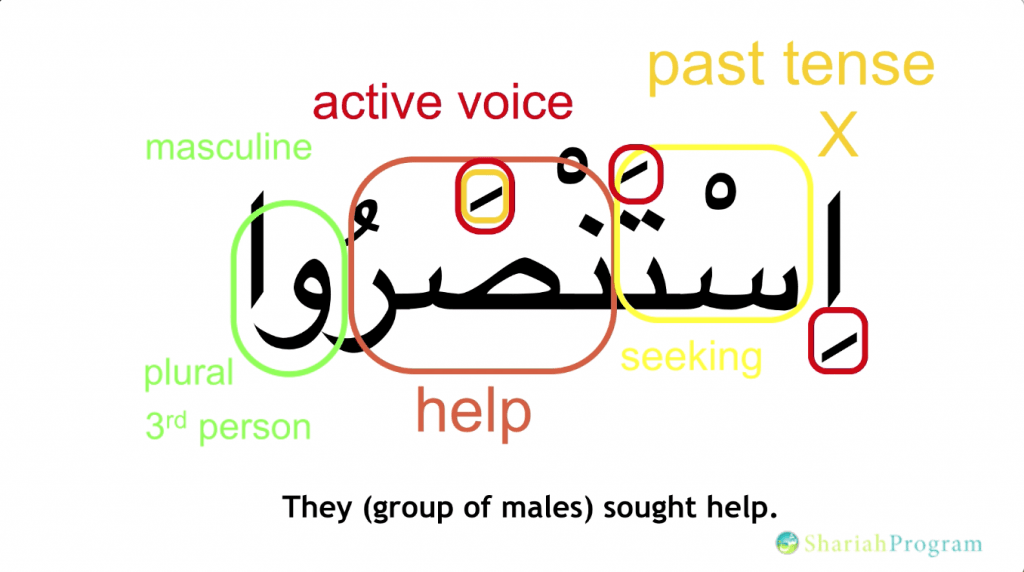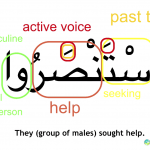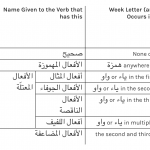Welcome to the LAO series of tutorials on Arabic Morphology (‘ilm us-Sarf).

What is Arabic Morphology?
The Arabic language sub-science known as صرف – referring roughly to what we know as Morphology as well as Etymology – is a subject through which one learns the internal assembly of a word by way of patterns of vowelization and introduction of extra letters—or what we call a template.
Morphology differs from Lexicology in the sense that the latter gives the root meaning associated to a set of base letters, whereas the former gives all other meanings and connotations achieved by the template.

Table of Contents
How we Study Arabic Morphology
In order to study Arabic morphology both completely and effectively, we divide the science into the following set of topics.
1. conjugation
a. Arabic verb conjugation – the study of how verbs are derived from a set of base letters and how they conjugate in the different tenses to reflect gender, plurality, voice, and other aspects
b. derived nouns – the study of nouns in the language that are also derived from a set of base letters and how they conjugate
2. verb paradigms – taking the basic verbal form and all its conjugations and adding certain extra letters in order to enhance its meaning and add certain connotations
3. verb irregularities – the study of how verbs (basic and enhanced) and derived nouns conjugate when they contain certain “weak” letters
a. Hamza verbs – regulations associated to verbs with a Hamza in any one of the three radicals (root letters)
b. assimilated verbs – regulations associated to verbs with a glide (واو or ياء) as the first radical
c. hollow verbs – regulations associated to verbs with a glide as the second radical
d. deficient verbs – regulations associated to verbs with a glide as the third radical
e. highly deficient verbs – regulations associated to verbs with multiple irregularities
f. duplicated verbs – regulations associated to verbs in which the final two radicals have geminated
4. paradigm connotations – the study of the specific connotations and enhanced meanings achieved by applying the paradigms studied in (2)
5. more advanced topics such as advanced etymology and others
The rest of this tutorial goes into greater detail and gives introductory information about each of the above topics.
For true proficiency in the language, however – beyond theory and simply reading basic and advanced tutorials – one must learn Arabic through courses such as the Shariah Program. The esteemed teachers in such courses employ time-tested techniques to activate a student’s theory and provide vital feedback. Not only that, they understand students and introduce appropriate material at very calculated points in time so as to maximize the learning experience and not overwhelm the students.
These tutorials on Arabic morphology will provide basic and advanced theory, but practicing the conjugations of regular and irregular verbs is very essential. This practice and its feedback can only be achieved by learning Arabic through courses.
Overview of Arabic Words
We divide words in Arabic into three self-contained categories as follows.
· اِسْم: (usually translated as “nouns”) includes nouns, pronouns, adjectives, adverbs, etc
· فِعْل: verbs
· حَرْف: particles, articles, and conjunctions
Particles are completely unpredictable; they don’t fall into the templatic system (i.e. they have no patterns) nor do they undergo any morphophonemic changes. They are what they are and must be memorized. The up side is that there are relatively few of them in the language – within one hundred.
Nouns and verbs do fall into the templatic system and have very systematic morphophonemic rules that govern them. This includes the study of how verbs are conjugated, how they move from pattern to pattern to enhance their meanings, how the participles and other nouns are derived, how nouns pluralize, etc.
Noun & Verb Overview
Each declinable noun and each verb is made up of a certain set of base letters, called its جذر. (Nouns that are always indeclinable (such as pronouns) usually don’t follow this system.)
Verbs can either have 3 base letters, or 4. Nouns can have 3, 4, or 5. Now these base letters can be augmented with extra letters, and they can be dropped or changed due to morphophonemic rules as well. Let’s look at some examples.
Added and Dropped/Changed Letters | Base Letters | Verb |
— | ح،
ي، ي | حَيَّ |
أ
added | ل،
ح، ق | أَلْحَقَ |
و
changed | ق،
و، ل | قالَ |
ء
and ي dropped,
ه
added | ر،
ء، ي | رَهْ |
ء
and ن added | ط،
م، ء، ن | اِطْمَأَنَّ |
Added and Dropped/Changed Letters | Base Letters | Noun |
— | ه،
م، س | هَمْس |
أ
and ا added,
ي
changed | ح،
ي، ي | أَحْياء |
ا
added, ي dropped | غ،
ز، ي | غازٍ |
ن
added | غ،
ض، ف، ر | غَضَنْفَر |
Why are letters added? This is a result of taking a set of root letters and putting them into a patter in the templatic system. We do this to add more meaning, depth, and connotation to the basic meaning afforded by the root letters. This is one of the concepts covered by morphology. For example, the base letters given in the chart below afford the basic meaning of cutting. But ‘cutting’ is too abstract a meaning, so these letters are then inserted into templates, thus giving them tangible and even advanced meanings. (We use the base letters فعل to represent what a template looks like).
Template | Base | ||||
فِعال | فِعْلَة | فُوْعِلُوا | إِفْعال | فَعَلَ | |
قِطاع | قِطْعَة | قُوْطِعُوْا | إِقْطاع | قَطَعَ | ق،
ط، ع |
section | fragment | they were boycotted, or interrupted | fief | he cut | to cut |
And why are letters dropped or changed? This is based on morphophonemic rules of the language which is the other major concept that morphology covers.
Introduction to the Templatic System
Each word in the language (noun or verb) is a combination of a set of base letters plus a given template. For example, the word إقْطاع is the base letters ق، ط، ع on the pattern إفْعال. The base letters give us a base meaning (cutting) and the pattern gives us a certain connotation (to do something to someone or something). Hence we get the meaning of ‘to cut something’. More specifically, the word means ‘fief’ which is a plot of land that has been cut or divided.
So we can think of each word in the language as an instantiation of a template using a set of base letters. But there are far too many templates in the language. So we have a layer of abstraction above templates which we call ‘template sets’.
For example, the words
مِلْعَقَة, مِفْتاح, عالَم
are instantiations of the patterns
مِفْعَلَة, مِفْعال, فاعَل
using the base letters
(ع، ل،
ق), (ف،
ت، ح), (ع،
ل، م)
respectively. And all of the templates belong to a set called اسم الآلة (nouns of utilization).
Final Meaning | Template Set | Template | Base | Base | Word |
|---|---|---|---|---|---|
spoon (that with which you lick) | اسم
الآلة noun of usage | مِفْعَلَة | to lick | ل،
ع، ق | مِلْعَقَة |
key (that with which you open) | مِفْعال | to open | ف،
ت، ح | مِفْتاح | |
world (that through which you learn (about God)) | فاعَل | to know | ع،
ل، م | عالَم |
Notes
· the meanings cannot be directly inferred; but this templatic system is extraordinarily useful in a) guessing meanings to words, and b) providing a framework for creating new words
· templates may be shared across several template sets
Introduction to the Morphophonemic Rules
There are a few letters in the language such that, if they are part of the base letters of a word, the word is considered weak. If a verbs is considered weak, a set of rules must be applied in order to change it so that it is no longer considered such. This discussion is mainly focused on three-lettered words, and we begin with verbs and then extend our knowledge to nouns later.
Below is a chart that gives these letters
Name of the Set of Rules Applied to this
Type of Verb | Name Given to the Verb that has this | Week Letter (and where it Occurs in the
Verb) | |
— | صحيح | None of the below | |
تخفيف | الأفعال
المهموزة | همزة
anywhere in the base | |
تعليل
or إعلال | الأفعال
المعتلّة | أفعال
المثال | واو
or ياء
in the first position |
الأفعال
الجوفاء | واو
or ياء
in the second position | ||
الأفعال
الناقصة | واو
or ياء
in the third position | ||
أفعال
اللفيف | واو
or ياء
in multiple positions | ||
إدغام | الأفعال
المضاعفة | the second and third letters are the same | |
There are at least 50 rules that govern what will happen when these letters occur in a word, based on surrounding letters, vowels, etc. However, when we study basic morphology, we only discuss at most 10 of these as they account for the vast majority of these occurrences.
The classification of words based on weak letters is parallel to their classification based on templates. This means that a word will have both a template as well as a weak-letter classification. For example, the verb قال (he said) is on the pattern فَعَلَ and, in terms of its weakness, it is among the الأفعال الجوفاء.
Want a Video Intro on Arabic Morphology?
Simply click the image below and fill the short form for free instant access.
A Cute Story
The templatic system covers the study of letters that are extra in a given word (i.e., part of the template and not the base letters). It is one of the most important skills for a student to be able to differentiate between base and extra letters. Without this skill, one will not even be able to look up words effectively in a dictionary.
Not every letter in the alphabet may act as extra. In fact, the letters that can are limited to the following 10:
ء،
ا، ت، س، ل، م،
ن، ه، و، ي
They can be memorized using the following phrases in which each of the above letters appears exactly once:
you asked me about it | سَأَلْتُمونيها
|
today you forget it | أَلْيَوْمَ
تَنْساهُ |
So a student once asked his teacher about which letters are capable of being extra in a word. The teacher answered سألتمونيها (you’ve asked me already). The student denied previously asking, so the teacher responded by saying, أليوم تنساه (today you forget, eh?). When the student insisted, the instructor said, “I have answered you twice but you still don’t understand.”
Arabic Morphology FAQ
What is Arabic morphology?
What are Arabic verb forms?
A basic verb form is the particular vowel configuration given to a set of 3 consonants in Arabic in order to turn those letters into an actual verb. Along with making the letters pronounceable, these vowels give us more meaning, namely the tense and voice. Verb forms can be simple and they can also be enhanced. Enhanced means the pattern involves the addition of one or two extra letters.
How many root consonants do most Arabic verbs contain?
The vast majority of verbs in Arabic contain 3 root consonants.

